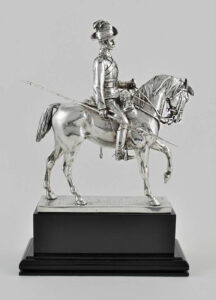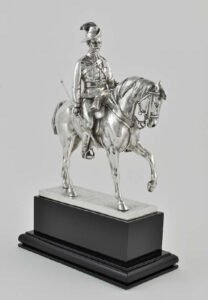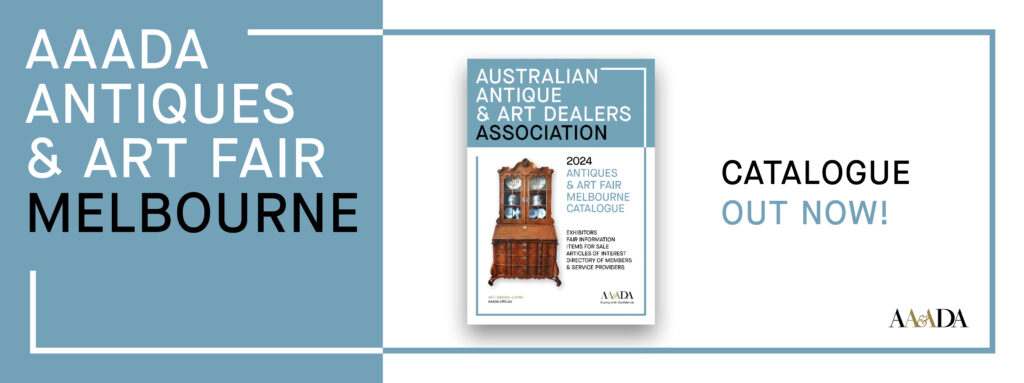Article
AND IN FRONT THE LANCERS RODE THAT NEW SOUTH WALES HAD SENT: WITH EASY STRIDE ACROSS THE PLAIN THEIR LONG, LEAN WALERS WENT.
JOHN HAWKINS

Lancer statuette, showing the lance and the emu
feathers in his hat, hallmarked for London, 1900.
Commissioned by the officers of the Lancer squadron as a gift to their Honorary Colonel, Lord Carrington, for his support of the squadron in England in 1899. Designed, made and cast in silver by the leading London Modeller of equestrian statuettes, Frederick Courthope in 1900. Weight 73 oz. height 32 cm.
Col Burns of Burns Philp arranged the sending of a squadron of one hundred Light Horsemen to be quartered, fed, horsed, and trained at the British Army cavalry barracks at Aldershot, under the auspices of Lord Carrington, the Honorary Colonel of the Lancers and former governor of New South Wales, who contributed £500 towards the costs of the project.
Colonel Burns opened a fund to conclude the matter with a personal donation of £300 and Regimental officers and other supporters subscribed a further £2,000. Serving soldiers in his exclusive Regiment were approached, and each applicant agreed to pay their own fare of £20. This meant that costs for the whole enterprise was covered by the individuals involved rather than the government of New South Wales.
The 1899 detachment under the command of Captain [later Major General] Charles Cox or “Fighting Charlie” as he was known by his men, was trained alongside the British 6th Dragoon Guards [Carabiniers] at Aldershot. When the Second Boer War broke out, Cox volunteered himself and his squadron before they left England for service in South Africa. When the ship which was transporting them home to Australia dropped anchor in Cape Town, advice was received that the offer was accepted by both the British and New South Wales governments and the New South Wales Lancers became the first Australian cavalry regiment to fight on foreign soil.
And in front the Lancers rode that New South Wales had sent: With easy stride across the plain their long, lean Walers went.Unknown, untried, those squadrons were, but proudly out they drew. Beside the English regiments that fought at Waterloo.
Andrew Barton Paterson, better known as Banjo, went to South Africa as a special Boer War correspondent for the major Sydney and Melbourne newspapers. He travelled with the first volunteers from New South Wales, arriving in Cape Town in late November 189. AND IN FRONT THE LANCERS RODE THAT NEW SOUTH WALES HAD SENT:
WITH EASY STRIDE ACROSS THE PLAIN THEIR LONG, LEAN WALERS WENT.

South Wales Lancer wearing
a slouch hat, as worn here for
ceremonial purposes with a
puggaree, and emu feathers,
the lance for use when
mounted, the sword when
dismounted. The trooper’s
regimental hat and collar
badges are in evidence.3
The slouch hat is strongly associated with Australian identity. The word ‘slouch’ refers to the sloping brim, made from rabbit-fur or wool felt and is always worn with a puggaree. The hat became the symbol of the Australian fighting man during World War One and continued to be worn throughout World War II, making the slouch hat a national military symbol.
By 1890, State military commandants had agreed that all Australian forces, except the artillery corps, should wear a looped-up hat of uniform pattern. The hat was turned up on the right side in Victoria and Tasmania, and on the left side in all other States, to allow for different drill movements General Bridges, the first commander of the 1st Australian Imperial Force, was found wearing his slouch hat reversed when he was fatally wounded at Gallipoli. As a mark of respect and remembrance for Bridges, when the slouch hat is worn at Royal Military College, Duntroon, it has become traditional to wear the chinstrap buckle on the right side of the face and the brim down. This tradition commenced at the Royal Military College in 1932.
The term ‘puggaree’ originates from the Hindu word ‘pagri’, meaning a turban or thin scarf of muslin. The Boer War puggaree had six pleats, one for each of the federated states. The current puggaree has eight pleats, one for each state and one for the Australian Territories. It is made from light khaki-coloured cotton and is worn on the slouch hat with a unit colour patch sewn on the right side. Royal Military College staff cadets wear a distinctive puggaree of olive drab colour. The eighth pleat signifies the graduation of the first international cadet through the Royal Military College who hailed from New Zealand.
The emu plume is still worn on slouch hats by members of the Australian Armoured Corps. This tradition originated with the Queensland Mounted Infantry during the great shearers’ strike in 1891. During this time, the Queensland Mounted Infantry were called out to aid the civil power. Tradition dictates that when time permitted, the soldiers would ride their horses alongside emus, or in South Africa, the ostrich, and pluck out the feathers, placing them on their hats. The Gympie Squadron was the first to wear the feathers and the rest of the regiment soon followed. The Queensland government permitted the Regiment to adopt the plume as part of its uniform in recognition of its service. In 1915, the Minister for Defence, Sir G. F. Pearce, granted all units of the Australian Light Horse permission to wear the plume, which they referred to as kangaroo feathers.
On the death of Lord Carrington, now 1st Marquess of Lincolnshire KG, GCMG, PC, DL, JP (16 May 1843 – 13 June 1928), his younger brother, Rupert Clement George Carington, now living in Australia, became 4th Baron Carrington, CVO, DSO, DL (18 December 1852 – 11 November 1929), inheriting his property but not titles. Rupert Carington (1852-1929) was a soldier, grazier and politician. He served in the Zulu War in 1879 as acting adjutant of the 1st Battalion, 24th Regiment of Foot, and later commanded a troop of mounted infantry. In 1884, he had retired from the Grenadier Guards with a gratuity and in 1887 came to New South Wales where his brother, Charles, was governor. He was appointed a captain on the headquarters staff of the New South Wales Military Forces and next year, on 23 March, was made aidede-camp to his brother, a post he held until 1890. On 23 March 1891 at St Matthew’s Anglican Church, New Norfolk, Tasmania, he married Edith, daughter of John Sutcliffe Horsfall and became a grazier and part-owner, with his father-in-law, of Momalong station in the Riverina.
Carington was placed on the reserve of officers in 1900 but in February 1901 went to the South African War as a major in the 2nd Regiment, New South Wales Mounted Rifles; he was promoted lieutenant- colonel in May 1902 and that month at Klerksdorp, Transvaal, formed and commanded the 3rd New South Wales Imperial Bushmen’s Regiment. This unit was made up of time-expired men from other Australian regiments and was later augmented by a draft of 200 Riverina bushmen raised and paid for by his father-in-law. Letters to his brother, Charles, give a vivid account of the actions and skirmishes of this stage of the war and he and his men received high commendation from Major General R. S. Fetherstonhaugh for their services in western and eastern Transvaal. Carington was awarded the Distinguished Service Order and mentioned in dispatches.
He returned to Momalong in July 1902 and was appointed C.V.O. in 1905. Carington commanded the 6th Australian Light Horse Regiment in 1904-10, the 2nd A.L.H.B. in 1910-15, and was an honorary aide-de-camp to the governors-general in 1912-17; he had been promoted colonel in 1911 and retired from the Australian Military Forces in 1918.

In May 1915, his brother’s only son, was killed in action and Carington became heir to the barony. He returned to England after World War I and in 1928 succeeded his brother Charles as fourth baron. He died of heart disease on 11 November 1929 at his residence in Eaton Place, Westminster. His wife had died in 1908 and their only son succeeded to the title. The two brothers were great supporters of both the Lancers and the Australian Light Horse.
When Governor of New South Wales, Charles Carrington had developed a good working relationship and affectionate regard for the NSW Premier, Parkes, whose determination in 1889 to promote Federation arose largely from their conversations. Carrington’s diplomatic work through the governors in Victoria and South Australia was crucial in paving the way for the Federation Conference of 1890. Lord Carrington’s official position of governor in pre-federation days carried the title of “Commander-in-Chief of the New South Wales Defence Forces”. In the early orders of the New South Wales Lancers, he is termed “Honorary Colonel” a position he held with great interest, munificence and practical assistance until his death in 1928. At his farewell dinner on 11 September 1890, his Lordship granted permission for his family crest. an elephant’s head with coronet and three fleur-de-lys, to be incorporated into a Regimental Badge to be worn by the New South Wales Cavalry, of which the Sydney Lancers were a part. In 1894, the regiment became the New South Wales Lancers until granted a “Royal” patent in 1935. The Carrington’s crest remains as the badge of the 1st/15th Royal New South Wales Lancers, an active Australian Army Reserve Cavalry regiment, with its headquarters at the Lancer Barracks in Paramatta.
The statuette was probably originally conceived as a present to Carrington by Lieutenant-Colonel James Burns, the order finally being placed by the squadron and its officers at the end of their training under Captain Cox, Lt. Osborne and Lt Rundle at Aldershot in 1899 before sailing home via South Africa.
On his return to England … Lord Charles Carrington’s first speeches caused a sensation by his espousal of Australian nationalism rather than imperial federation, and his indictment of the “old ball and cartridge blunders” by which Tory secretaries of state had offended colonial sensibilities. The attacks had the obvious bias of a Liberal returning to party activity but made good sense, countered the shallow anti-gubernatorial witticisms of the Bulletin, won wide approval and vindicated Carrington’s intelligent
attachment to New South Wales.
The maker’s mark, F.C in a clover-shaped lozenge, is for Frederick Courthope. His obituary quoted in Culme notes from a quotation that one of his fellow silversmiths stated that: he was a master silversmith in every sense of the word and a particularly clever modeller of equestrian statuettes. The Goldsmiths & Silversmiths Company, when approached by Burns and his fellow officers, must have commissioned this piece from Courthope which took time to model and complete the figure after the squadron had departed for South Africa.
NOTES
https://www.bwm.org.au/units/NSW_Lancers.php
Banjo Patterson’s ‘With French to Kimberley’, stanza 3
https://alh-research.tripod.com/Light_Horse/index.blog/1813456/all-light-horsemen-wore-emu-plumes/
